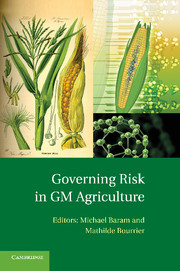1 - Governing Risk in GM Agriculture
An Introduction
Published online by Cambridge University Press: 01 March 2011
Summary
Biotechnology and the Transformation of Agriculture
Biotechnology is generating the knowledge and skills for modifying all forms of life – plant, animal, human, and microbial. It is enabling researchers to map the genetic composition of organisms and identify the functions of their genes, and to determine the roles that selected genes play in creating proteins that, in turn, establish the physical and biological traits of the organisms. With this knowledge, researchers are then able to conceptualize modified versions of selected organisms that would be endowed with new traits, such as various species of plants, and undertake a process that subsequently involves splicing new genetic material into the genomes of the plants to modify their genetic composition and proteins. If successful, the redesigned plants will have the new intended characteristics. Thus, the scientific approach to agriculture pioneered by Mendel and others in the nineteenth century is dramatically amplified by biotechnology.
Over the past decade, commercial interests have promoted genetic modification (GM) of basic commodity food crops such as corn, soy, and rice, and important nonfood crops such as cotton, to endow these species with traits that will enhance agricultural productivity. Notable achievements include modified versions of selected crops with superior ability to withstand the chemical herbicides used in agriculture to eradicate weeds and to withstand various insect pests, crop diseases, frost, and drought.
- Type
- Chapter
- Information
- Governing Risk in GM Agriculture , pp. 1 - 12Publisher: Cambridge University PressPrint publication year: 2010



